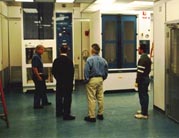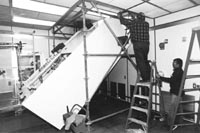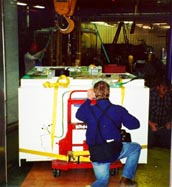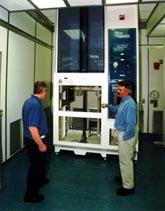Technology Transfer in the Making
Hall C Performing Like Seasoned Pro
Clean Room Prepares for Accelerator Equipment Processing
Review Yields Positive Results
- Catch March Madness Party with JAG
- Admin. Review Scores Outstanding Rating
- Security Survey Takes Place March 16-18
- Check Out Latest Lab Events on Web Page
- Update
Lab Sets June 26 for Open House
Technology Transfer in the Making
Gamma camera's future looks bright
by James Schultz
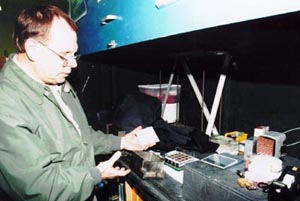 Stan Majewski, head of Jefferson Lab's detector group, heeded his wife's insistence that he work neither Christmas eve nor day. But while friends and family enjoyed an extended holiday break in late December, Majewski found himself back in the laboratory keeping long hours. His mission: to track down a malfunction bedeviling one of the Lab's most successful examples of technology transfer.
Stan Majewski, head of Jefferson Lab's detector group, heeded his wife's insistence that he work neither Christmas eve nor day. But while friends and family enjoyed an extended holiday break in late December, Majewski found himself back in the laboratory keeping long hours. His mission: to track down a malfunction bedeviling one of the Lab's most successful examples of technology transfer.
While in late-autumn clinical trials at Johns Hopkins University in Baltimore, the device, a breast imager derived from JLab expertise in gamma-ray detection, was unable to produce clear pictures of potential tumors. Alarmed, the imager's licenser, Dilon Technologies, Inc. of Newport News, turned to Majewski for help.
Majewski and his team traced the difficulties to pressure-induced mechanical fluctuations that occurred after the instrument's original calibration in September 1998. The fluctuations affected a key optical coupling, located in the imager's detector head, creating distortions in breast-imaging readouts. Operators could have ameliorated the problem by re-calibrating the instrument prior to examination, but were unfamiliar with the machine's capabilities. The answer: Majewski modified the optical coupling, adding thicker padding to cushion components, and issued more explicit calibration guidelines.
"This technology is on the fast track to implementation," Majewski says. "We've put ourselves under tremendous pressure. For a while there I was wondering: Have we made a system that works? I felt we did. It was a matter of figuring out what was going on and then fixing it. Which is what happened."
Unique and Precise
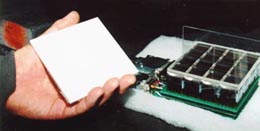 The "gamma camera" - called the Dilon 2000 by its manufacturer - has its origins in the sensitive gear used in the Lab's experimental halls to detect subatomic particles. Thus it was in 1994 that the Lab's Detector Group adapted JLab detector technology in the creation of a portable, scale-model imager to be used in conjunction with traditional x-ray mammography. The Lab's gamma camera would prove especially sensitive to small breast tumors that otherwise might escape detection.
The "gamma camera" - called the Dilon 2000 by its manufacturer - has its origins in the sensitive gear used in the Lab's experimental halls to detect subatomic particles. Thus it was in 1994 that the Lab's Detector Group adapted JLab detector technology in the creation of a portable, scale-model imager to be used in conjunction with traditional x-ray mammography. The Lab's gamma camera would prove especially sensitive to small breast tumors that otherwise might escape detection.
Breast tissue varies in density. In x-ray mammography, and particularly in the case of younger women, dense tissues create shadow images that can shroud the extent of cancerous tumors too tiny to be easily seen. The gamma camera can track injectable "radiopharmaceuticals" (slightly radioactive isotopes) as they accumulate in a patient's malignant cells and then sense emitted particles. The particles are in turn converted into electrical signals and interpreted as a real-time, computer-aided image of the entire breast.
Having licensed the Lab technology, Dilon Technologies is bullish about the gamma camera. More Dilon 2000 prototypes are under development and should be deployed over the next several months in clinical trials in hospitals around the country. Dilon expects that when production is ramped up, the company could annually produce up to several hundred of the $130,000 breast imagers.
The camera will come in two versions: six-by-eight inch and five-by-five-inch sizes respectively. The technology may also one day be adapted into additional, "application-specific" diagnostic devices for other parts of the body.
"By the end of this year we'll be shipping product," predicts Lee Fairchild, Dilon's director of product marketing. "Initial items will be sold to high visibility sites - people who are doing and who are known for breast imaging."
Fairchild credits Majewski and his team for "a super job," characterizing Dilon's relationship with the Lab as "excellent." For his part, Majewski believes most of the gamma camera's outstanding technical issues have been resolved. Now, he contends, it will be a matter of operator training and repeated use to take full advantage of the camera's promise.
"In comparison with other instruments, the camera appears to perform well," Majewski says. "We believe it will provide significantly better images of small lesions."
Hall C Performing Like Seasoned Pro
Provides ability to perform one-of-a-kind experiments
by James Schultz
Hall C isn't quite five years old, having opened its doors to researchers in the summer of 1994. Despite its relative youth, the hall is performing like a seasoned pro. Laboratory staff are currently preparing for the installation of five short experiments in the hall which will run concurrently through the end of the calendar year.
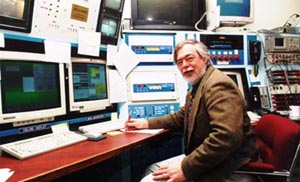 "Hall C really complements the other halls," says Don Geesaman, senior physicist at Argonne National Laboratory near Chicago, and chair of the JLab Users Group board of directors. "The program is developing just as we expected. Results from Hall C experiments are having a big impact in the field."
"Hall C really complements the other halls," says Don Geesaman, senior physicist at Argonne National Laboratory near Chicago, and chair of the JLab Users Group board of directors. "The program is developing just as we expected. Results from Hall C experiments are having a big impact in the field."
The $23 million hall is unique among the Laboratory's experimental facilities in its ability to accommodate a variable array of equipment for complex, extended investigations. Reconfiguration can be laborious with instrument changeovers usually taking three to four months.
"It's not just putting equipment into an empty building. You have to dismantle what's already there - then put it back to standard configuration when you're done," says Hall Leader Roger Carlini. "At Hall C we are constantly in flux - which is both a blessing and a curse. The changing and reconfiguring never ceases. That makes for interesting physics, but also for a hectic and intense life."
Of the 10 experiments conducted so far in the hall, seven have been completed, with results published in peer-reviewed journals. Three experiments have collected partial data and are expected to complete their runs in the near future. Carlini estimates that 27 Ph.D.-candidate students have obtained data from the hall's various investigations. Nine have gone on to earn doctorates in physics.
"The bottom-line metrics here are how may experiments you complete; the quality of those experiments and the resulting physics; and how many students you train," Carlini says. "Those are our 'products,' the things that matter. By those measures we're at the very top."
Unique Research In An Expensive World
In Hall C, as in the Lab's other two halls, the physics objective is nothing less than a more fundamental understanding of the nature of the atomic nucleus and of all matter.
"The world around us is made up mostly of quarks held together by their interactions," says Don Geesaman. "We're trying to see the quark structure of atomic nuclei. What we're trying to do is make quantifiable measurements of things we've had hints of. It lets us know if we have all the pieces right."
Testing those pieces, however, does not come without cost. Geesaman says that one issue Hall C users and the Lab's Program Advisory Committee must continually address is increasing expense. Because of Hall C's capabilities and its mandate to carry out one-of-a-kind experiments, the complexity of those experiments and experimental equipment was underestimated when initial budgets were devised. Now, it is difficult to economize where labor and equipment are concerned.
"We've shown we can move in the big equipment and perform experiments successfully," Geesaman notes. "But resources remain quite limited. The experiments are getting more expensive to do. That's the only issue I'm really concerned about."
Nevertheless, hall staff are prepping for the installation of a "hypernuclear" spectrometer by the end of 1999. The hall will also welcome a second-generation quasi-permanent fixture, a toroidal spectrometer, scheduled for sometime late in 2001. Other equipment is also on order, to make use of the Lab's planned 2005-2006 electron beam upgrade.
Clean Room Prepares for Accelerator Equipment Processing
|
|
|
|
Review Yields Positive Results
Team compliments Lab safety management program, culture
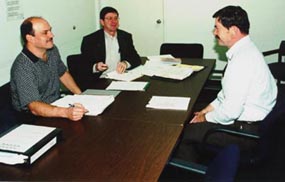 The Department of Energy's Integrated Safety Management (ISM) verification review team left Jefferson Lab March 4 after presenting its results to nearly 100 Lab staff. According to Team Leader DeVaughn Nelson, Office of Science, DOE/Germantown, the team found no critical concerns and no serious weaknesses in the Lab's Integrated Safety Management program.
The Department of Energy's Integrated Safety Management (ISM) verification review team left Jefferson Lab March 4 after presenting its results to nearly 100 Lab staff. According to Team Leader DeVaughn Nelson, Office of Science, DOE/Germantown, the team found no critical concerns and no serious weaknesses in the Lab's Integrated Safety Management program.
He said the Lab demonstrates a vigorous, integrated EH&S program and culture; and the team's final report will recommend DOE approval of the Lab's Integrated Safety Management System (ISMS) plan.
The results of the review team's four-day look at the Lab's safety program and culture was very positive and reflected both the thorough, professional work of the team as well as the firm foundation upon which the Lab's environmental, health and safety program is rooted.
During the close-out briefing, Nelson said, "The results [of the review] are no surprise. It is obvious that the Lab staff and leadership are committed to doing a job right the first time. The Lab has already achieved a level of excellence in science. It has a strong ISM program in place and a positive safety culture."
He complimented the Lab on the many strong points identified by the team, and specifically commended the Lab's safety training program, its strong commitment to safety and its integrated EH&S culture. The team called the Lab's relationship with the DOE Site Office "outstanding" and described it as a real partnership. They also commended the Site Office Operations Awareness program as being mature and providing a powerful tool for ISMS validation. In accordance with guidance from the Office of Science in DOE, the Site Office's program will be used instead of having a separate validation review as is done at labs under other DOE program offices.
To further improve and enhance Integrated Safety Management, the team suggested that Lab management walk through work areas more often; use EH&S performance metrics to improve behavior at all levels of the staff; develop a process for periodically updating the Work Smart Standards; and make the ISMS plan fully reflect the strong program they saw during their review.
The review team's mandate was to determine how well the Lab has integrated EH&S into its processes and culture. Integrated Safety Management incorporates the Lab's ability to carry out high-quality physics efficiently and effectively while maintaining a safe and responsible workplace and satisfying all legal obligations. With respect to the Lab's EH&S program, ISM means being able to recognize and anticipate hazards, identify relevant obligations, develop and implement appropriate control methods and always continue learning from our experience as we do our jobs.
The team reviewed the Lab's ISMS plan and training program; they held numerous interviews and conducted a Lab walk-through. "We watched people calmly doing their work. We saw a real, genuine commitment to safety as a priority," Nelson said. "We must always maintain that vigilance. As you know from the mishap in Hall C, continuous communication isn't easy, but it is important to maintaining safety. You have a good working program, but now you must commit to making it happen every day. None of us are immune from being careless or falling into a routine. Always take the time to look out for each other's best safety interests."
Nelson concluded the close-out briefing by thanking the Office of Technical Performance for the outstanding support it provided during the review. The team offered a special "thank you" to Administrative Assistant Julie Oyer for all the preparatory work she did for the team before their visit to the Lab, and for the administrative support she provided during the review.
"Jefferson Lab has always believed, and DOE has now mandated, that workers and line managers decide how the work they are doing can be accomplished safely," explained Ron Sundelin, Associate Director, Office of Technical Performance. "We are pleased with the team's findings and appreciate the contributions of the many staff members, users, and subcontractors who demonstrated to the team that we have an integrated and highly effective EH&S program in place. Several of the team members mentioned that they were anxious to get back to their home institutions so they could start implementing what they learned here."
FEL Hits New Record!
Recent runs bring laser beam to higher powers
The Free Electron Laser was back on track during March with record setting days becoming a matter of course. Pictured in the accelerator Machine Control Center as they oversee an FEL run are (back to front) team members Kevin Jordan, Lia Merminga, George Neil and (standing) Court Bohn on a day early in the month when the FEL surpassed its previous records and hit a high of 500 watts. But even that record fell on March 11 when the FEL hit an all time high of 710 watts at 3.6 milliamperes. That doubles the FEL team's last celebrated high of 311 watts achieved on July 30, 1998. The team is well on its way of reaching one of the machine's design goals-1 kilowatt. Congratulations to all of the staff that made this achievement possible!
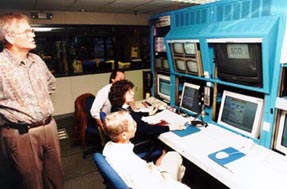
DMV-On-Wheels Visits JLab
Take advantage of quick, convenient service
The Department of Motor Vehicles mobile customer service center is coming to Jefferson Lab later this month and several times throughout the year. Take advantage of this convenient opportunity to take care of a number of your driving and vehicle needs. At this mobile unit you can:
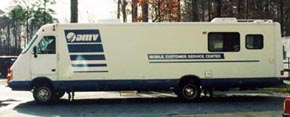
Or, if you have questions about any of these items, stop by the mobile customer service center to get your questions answered.
The scheduled Lab visits for 1999 are March 22, April 26, June 28, July 26, August 23, September 27, October 25, and November 22. On these days the DMV mobile unit will be parked beside Building 19 (the Forestry Building) and will be open continuously from 9 a.m. to 4 p.m. to serve all walk-in customers.
According to Cela Callaghan, Accelerator Division, if response is good, the DMV will plan to visit Jefferson Lab once a month next year, also. Taking advantage of this convenient service allows you to save your vacation time and Saturdays for other activities!
- Take your driver's license written and skills tests
- Obtain original driver's license
- Receive a duplicate driver's license
- Renew a driver's license
- Take the Commercial Driver's License written test
- Receive a Commercial Driver's License
- Receive driving record reports
- Update driver information (address, name changes, etc.)
- Obtain photo identification cards
- Register, renew and title vehicles
- Obtain vehicle decals
Catch March Madness Party with JAG
Plan on joining the Jefferson Lab Activities Group for the March Madness Mardi Gras on March 26 behind the Residence Facility.
The Lab-wide spring morale booster will start at 3 p.m. Cajun food is on the menu and entertainment will include jazz music, a limbo contest, a tug-of-war rematch and a basketball shootout. For more information about the event, or to volunteer to help with food/beverage service or any of the activities, call Richard Dickson at ext. 5082.
The JAG T-shirt subcommittee received six design entries and posted them on the JAG Web Page. On-line voting to select the design for this year's shirt ended March 12. The winning design will be unveiled May 6 at the 1999 Run-A-Round. The person with the winning design will receive a free T-shirt and $25 in JAG Bucks. View past years' winning designs at: www.jlab.org/user_resources/userliaison/tshirt/tshirt_winners.html.
Admin. Review Scores Outstanding Rating
The Lab's 1999 Administrative Peer Review was held February 23-25; and for the first time, the Administrative Division received an overall rating of Outstanding.
"It was a major effort," said Administration Division Associate Director Roy Whitney, "and we are delighted with the results." The Administrative Peer Review is a "key indicator" for SURA's performance-based management contract with the Department of Energy.
During the three-day session, the panel heard from SURA President Jerry Draayer, DOE Acting Site Office Manager Jerry Conley, Lab Director Hermann Grunder, all departments within the Administration Division and key staff from across the Lab. Review panel members included representatives from the DOE, associate directors from other research laboratories, the user community, and business.
Security Survey Takes Place March 16-18
The Lab is going through a Safeguard and Security Survey March 16-18. Two evaluators will be on site conducting the survey, says Tom Briggs, Structural Maintenance and Services section manager.
They will review the Lab's emergency and site security plans, check security procedures around the Lab, and meet with DOE Site Office staff. The survey takes place every two years.
Check Out Latest Lab Events on Web Page
Catch up on in-house Jefferson Lab recreation and staff events by visiting the Lab's news web page at www.jlab.org/news/. Go to the lower left corner of the news web page (On Site Only) and select Lab Events, or you may go to it directly at: www.jlab.org/news/labevents/.
The site currently includes photos and highlights from the Black History Month International Food Festival and the Red Cross Blood Drive, both held on February 26.
Due to limited space in the Lab's monthly newsletter, it isn't always possible to cover these events in ON TARGET. Public Affairs uses the web page to share this information with Lab staff and users. If there's an event or activity you would like to see on the Lab Events web page, call Linda Ware, ext. 7689
Update
Navy Brass Visits FEL Facility
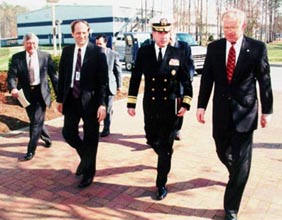 Rear Admiral Paul Gaffney, Chief of Naval Research and Director of Test & Evaluation and Technology Requirements for the Navy, visited the Lab on February 16 with Donald Upson, Secretary of Technology for the State of Virginia. The Free Electron Laser was built under the guidance of staff working for Admiral Gaffney. After attending a briefing on the current status and capabilities of the FEL, the Admiral toured the FEL User Facility before returning to Washington, D.C. Here the admiral and Secretary Upson are accompanied by Lab Director Hermann Grunder (far left) and FEL Program Manager Fred Dylla.
Rear Admiral Paul Gaffney, Chief of Naval Research and Director of Test & Evaluation and Technology Requirements for the Navy, visited the Lab on February 16 with Donald Upson, Secretary of Technology for the State of Virginia. The Free Electron Laser was built under the guidance of staff working for Admiral Gaffney. After attending a briefing on the current status and capabilities of the FEL, the Admiral toured the FEL User Facility before returning to Washington, D.C. Here the admiral and Secretary Upson are accompanied by Lab Director Hermann Grunder (far left) and FEL Program Manager Fred Dylla.
Lab Sets June 26 for Open House
Plans underway for variety of displays, hands-on activities
Mark your calendars: Saturday, June 26 is the date for Jefferson Lab's first Open House in four years!
The accelerator will be down the month of June for scheduled maintenance, allowing us the rare opportunity to open the Lab to the public. We hope to open a section of the accelerator and an experimental hall, and have exhibits and displays set up across the site, says Linda Ware, Public Affairs manager.
A committee of Lab staff from all divisions has already started meeting to plan the event. In addition to the many activities and exhibits held during previous Lab Open House events, this year other organizations, such as NASA, the Air & Space Museum, The Children's Museum of Virginia, and the ARC consortium members are being invited to set up exhibits and activities. A number of the hands-on math and science activities will be geared specifically toward children.
To carry the event off, many volunteers will be needed to perform cryogenic demonstrations; help develop and prepare exhibits; staff exhibits, displays and booths; act as tour guides and answer questions; help with crowd movement or act as escorts. When the time comes, please volunteer and help make this event a success. Let's give a sincere "thank you" to the region for its on-going support of the Lab.
Editor's note: If you have or know of a website that could be informative or useful to Jefferson Lab staff, call the public affairs office at ext. 7689 or e-mail Linda Ware (ware@jlab.org).
This month we're visiting the U.S. State Department web site at http://travel.state.gov/. It is an expansive site chock full of interesting and useful information. A mouse click on "faq" takes you to a bookmarked section with answers to the site's most frequently asked questions. Also easy to access is the web site's index. Starting to think about an overseas vacation? Here you can get the latest information on passports, current international travel restrictions, and travel health issues and warnings.


